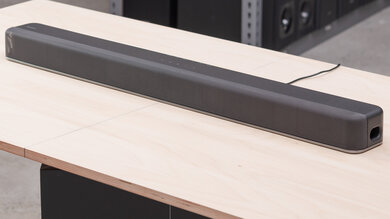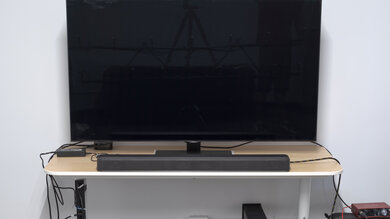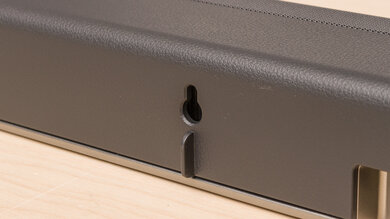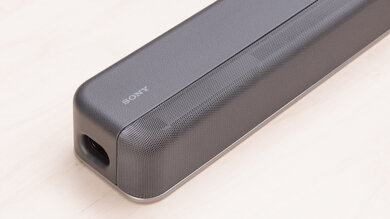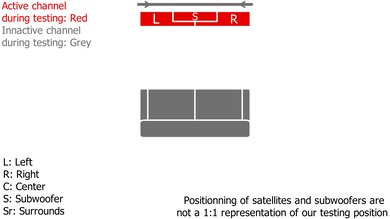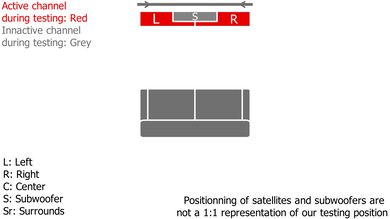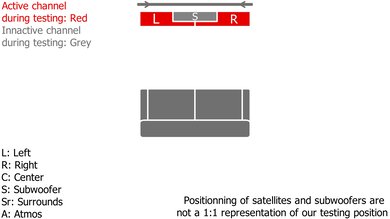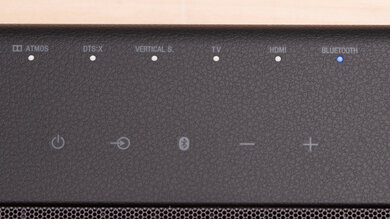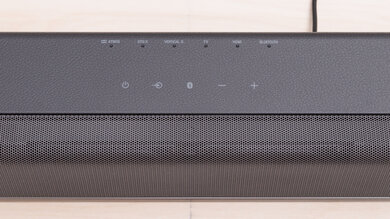The Sony HTX8500 is a 2.1 setup from 2019. This standalone soundbar has a subwoofer integrated into the bar to help save space, and it uses Sony's S-Force Pro Front Surround technology to help create a more immersive sound. Unlike many other 2.1 setups, it supports Atmos and DTS:X content, and its Vertical Surround Engine technology helps reproduce a fuller and more cinematic sound. Its sound profile is a bit boxy and dark, but vocals are still reproduced clearly, making it a solid choice for soap operas and audiobooks.
Our Verdict
The Sony HTX8500 soundbar is alright for mixed usage. This 2.1 setup has a boxy and slightly dull sound profile, though it can still reproduce vocals and lead instruments pretty accurately. Despite its dual subwoofers integrated into the bar, you don't feel the rumble in the low-bass with bass-heavy music or action-heavy movies. Unlike many other 2.1 setups, it supports Atmos content, but its performance isn't the most immersive since it has to downmix it into surround sound.
-
Can play Atmos and DTS content.
-
EQ presets plus bass adjustment feature available.
-
No room correction feature.
-
Lacks low-bass.
The Sony HTX8500 is decent for dialogue-centric content like TV shows. Its sound profile is a little boxy and dull, but voices are still reproduced pretty clearly. There's even a 'TV' preset that doubles as a dialogue enhancement mode. However, due to its 2.1 design, it has to use its left and right channels to simulate a phantom center, which doesn't sound as clear and real as a discrete setup. Voices don't seem anchored to a pinpoint location in the soundstage.
-
Dialogue enhancement and night mode feature available.
-
Bluetooth compatible.
-
No room correction feature.
-
No discrete center channel.
The Sony HTX8500 is okay for music. Though dual subwoofers are integrated into the bar, it still struggles to reproduce the low thump and rumble in the bass range, so it's not ideal for bass-heavy genres like EDM. Its sound profile is boxy and dark, but vocals and lead instruments are still reproduced pretty clearly. There's a bass adjustment feature to help you customize its sound, but unfortunately, there's no treble adjustment or graphic EQ available.
-
EQ presets plus bass adjustment feature available.
-
Bluetooth compatible.
-
Always-on surround sound feature.
-
Lacks low-bass.
The Sony HTX8500 is adequate for movies. Its boxy, slightly dull sound profile can still reproduce dialogue quite clearly. However, despite its dual subwoofers, it lacks the low thump and rumble in the bass you feel during action-heavy scenes. It supports Dolby Atmos content but has to downmix it into surround to play it. Similarly, its surround performance isn't the most impressive.
-
Can play Atmos and DTS content.
-
EQ presets plus bass adjustment feature available.
-
Always-on surround sound feature.
-
Lacks low-bass.
- 6.8 Mixed Usage
- 7.2 Dialogue/TV Shows
- 6.5 Music
- 6.6 Movies
- Updated Nov 21, 2023: Updated the text for greater clarity and consistency. No changes in test results.
- Updated May 05, 2023: Updated Video Passthrough To TV results with new methodology.
- Updated May 05, 2023: Converted to Test Bench 1.2. Updated the results for audio format support via ARC/eARC, HDMI In, and Optical. Added Video Passthrough to TV results as well.
- Updated Mar 20, 2023: Added cable lengths to In The Box.
- Updated Mar 16, 2023: Converted to Test Bench 1.1. With this update, we've added a Mounting test and added information aboutSubwoofer Output, Spotify Connect, and Microphone Mute.
- Updated Nov 11, 2022: Added the Vizio M Series M215aw-K6 as a Market Comparison to the Sound Enhancement Features box.
- Updated Dec 22, 2021: Updated review for accuracy and clarity.
- Updated Feb 12, 2021: Converted to Test Bench 1.0.
- Updated Sep 21, 2020: The Dynamics tests have been reconducted due to a value input bug.
- Updated Jul 27, 2020: Review published.
- Updated Jul 22, 2020: Early access published.
- Updated Jul 15, 2020: Our testers have started testing this product.
- Updated Jul 10, 2020: The product has arrived in our lab, and our testers will start evaluating it soon.
- Updated Jun 28, 2020: We've purchased the product and are waiting for it to arrive in our lab.
Differences Between Sizes And Variants
This bar is available in 'Black'. Let us know in the forums if you come across another version, and we'll update our review.
Compared To Other Soundbars
The Sony HTX8500 soundbar is a 2.1 setup. Like the Sony HT-S200F, it has a subwoofer integrated into it, but it's similarly unable to reproduce a thumpy low bass. However, this bar stands out because it supports Atmos and DTS content, which is fairly uncommon in 2.1 channel setups. It's an otherwise pretty ordinary-performing soundbar and doesn't stand out amongst its competitors, especially when compared to other 2.1 setups like the Yamaha YAS-408 or the Samsung HW-T550.
Check out our recommendations for the best Dolby Atmos soundbars, the best soundbars with subwoofer, and the best soundbars under $200.
The Sonos Beam (Gen 2) is a better standalone soundbar than the Sony HT-X8500. The Sonos is a better-built 5.0 setup that offers better soundstage, center, surround, and Atmos performances. Unlike the Sony soundbar, it also has built-in voice assistant support. That said, only the Sony has a Full HDMI In port for high-quality passthrough.
The Sonos Beam is a better soundbar than the Sony HT-X8500. The Sonos is a 3.0 setup that's better built, has a discrete center channel that performs better than the Sony soundbar's phantom center, and has a better stereo soundstage. You can also stream music to it using Wi-Fi or Apple AirPlay. However, even though the Sony soundbar's height channel performance is sub-par, it supports Atmos, which is rare for a 2.1 setup. The Sony also has EQ presets, an HDMI Out, and a Full HDMI In port, which is nice.
The Sony HT-X8500 is a 2.1 setup that's better for movies than the 2.0 setup Bose TV Speaker. Even though it doesn't get much louder than the Bose, the Sony has significantly better stereo dynamics. Its surround performance is better and it supports Atmos, which is great if you watch a lot of movies. The Sony also has EQ presets, its HDMI ARC and HDMI In ports support all common audio formats, and it supports DTS via Optical. It even supports eARC. However, the Bose feels better built, its sound profile is better balanced and neutral, and it's more compact overall, which some users may prefer.
The Sonos Arc is a better soundbar than the Sony HT-X8500. The Sonos is better built, with better soundstage, center, surround, and Atmos performances. It also comes with a room correction feature and can be upgraded to the Sonos Arc with Sub + One SL Speakers. However, the 2.1 Sony has some EQ presets and a Full HDMI In port, unlike the Sonos.
The Sony HT-G700 is a better soundbar than the Sony HT-X8500. The HT-G700 is a 3.1 setup that's better built and offers better soundstage and surround performances than the 2.1 HT-X8500.
The Sony HT-X8500 and the Sony HT-X9000F are similarly performing soundbars. While both soundbars can play Atmos content, the HT-X8500 has a better height performance. It has a bit better-balanced center channel, even though it doesn't have a dedicated center channel either. Although it can't get as loud as the HT-X9000F, it also can reach its max volume with less thumping and compression artifacts. Conversely, the Sony HT-X9000F feels slightly better built, and it has a standalone subwoofer. It also has both an Analog Audio In port as well as a USB input.
Depending on your listening habits, you may prefer either the Yamaha YAS-209 or the Sony HT-X8500. The Yamaha comes with a dedicated subwoofer and reproduces a more extended low-bass. It also has built-in voice assistant support and offers more wireless playback options. That said, the Sony supports Dolby Atmos content, which some listeners may prefer.
The Samsung HW-Q700A is better than the Sony HT-X8500. The Samsung is better built, and it has better soundstage, center, surround, and Atmos performances. It also reproduces a more extended low-bass and supports more wireless playback options. You can even use its graphic EQ to customize its sound.
The Sony HT-X8500 is more versatile than the Sony HT-S100F. The HT-X8500 is a 2.1 standalone bar with Dolby Atmos support. It has a better surround performance, too, and it comes with some extra sound enhancement tools such as a bass adjustment feature. That said, the HT-S100F is still a decent choice for dialogue-heavy content like TV shows and podcasts.
Depending on your listening habits, you may prefer either the Bose Smart Soundbar 300 or the Sony HT-X8500. The Bose is a 3.0 setup that's better-built and comes with built-in voice assistant support. It offers better soundstage and center channel performances, and it supports more wireless playback options. However, the Sony supports Dolby Atmos content, unlike the Bose. It also comes with a few more sound enhancement features, including auto-volume mode and EQ presets, and it has a Full HDMI In port.
The Samsung HW-Q600A is a better soundbar than the Sony HT-X8500. The Samsung is a 3.1.2 setup that comes with a dedicated subwoofer and reproduces a more extended low-bass. It's better-built, with better soundstage, center, and Atmos performances. It also comes with a graphic EQ for sound customization, unlike the Sony.
The Sony HT-X8500 and the TCL Alto 8i are both 2.1 soundbars that support Dolby Atmos, but the Sony has a better performance. The Sony has a more balanced sound profile, and its center, surrounds, and height channels perform better. It also comes with a dialogue enhancement feature and supports DTS content, unlike the TCL. However, the TCL has a better soundstage performance.
The JBL Bar 9.1 is much better than the Sony HT-X8500. The JBL is a 5.1.4 setup with a dedicated sub and satellites. It's better built, and it gets louder. It also has better soundstage, center, surrounds, and Atmos performances. There are also more sound enhancement features available, including room correction.
The JBL Bar 5.1 Surround is better than the Sony HT-X8500. The JBL is a 5.1 setup with a dedicated subwoofer that can reproduce a more extended low-bass. It's better built, and it has better soundstage, center, and surround performances. That said, it doesn't support Dolby Atmos content like the Sony.
The Samsung HW-S60A is better than the Sony HT-X8500. The Samsung is a 5.0 setup that's better built, and it has built-in voice assistant support. It has better soundstage, center, and surround performances, and more wireless playback support options. Also, it has a graphic EQ for sound customization. That said, only the 2.1 Sony supports Atmos content, which some users may prefer.
The JBL Bar 5.0 MultiBeam is a better soundbar than the Sony HT-X8500. The JBL is better built, with a room correction feature. It also has a better center, surround, Atmos, and soundstage performances.
The Vizio M Series M215aw-K6 is a better 2.1 Atmos soundbar than the Sony HT-X8500. The Sony's standalone design is nice if you're low on space, but since the Vizio comes with a dedicated subwoofer, it adds more bass to the mix. The Vizio has more sound enhancement features, and its stereo soundstage is better.
Test Results
The subwoofer is integrated into the bar.
The bar's build quality is decent. It's made from robust matte plastic and has a metal grille to protect its speakers. The subwoofers are integrated into the bar, and the metal grille protects it. Its ports are located on the sides of the soundbar. If you're looking for a soundbar with better build quality, check out the Vizio M-Series M21d-H8R.
The Sony HTX8500 has an adequate stereo frequency response. Although it comes with integrated subwoofers, it still struggles to reproduce the thump and rumble in the low-bass. Its sound profile is a bit boxy and dark, but vocals and lead instruments are still reproduced quite clearly and accurately. There's also a bass adjustment feature to help you customize its sound as well as some EQ presets.
With its bass set to '-1', this soundbar has a slope closer to zero, meaning it has a more neutral sound with stereo content. However, it still struggles to reproduce the thump and rumble in the low-bass. Its mid-range is pretty neutral, meaning that vocals are reproduced clearly, but they can also seem dull due to the recessed treble. Unfortunately, you can't adjust the bar's treble.
The Sony HT-X8500 has a mediocre stereo soundstage. It's about the size of the bar, and the bar doesn't do any tricks to widen the soundstage. It has a diffused focus, so objects sound like they come from more general areas rather than precise, accurate locations. For a 2.1 setup with a better soundstage, check out the TCL Alto 8i.
It's a 2.1 setup, so it doesn't have a dedicated center speaker. Instead, it uses its left and right speakers to simulate a sound in the center, which sounds more diffused and less clear than a dedicated center speaker. That said, its performance is still okay, and although it has an uneven bass range, there isn't a lot of bass on the center channel anyway, so voices sound fairly clean and accurate.
It's a 2.1 setup, so it downmixes surround content into stereo, which doesn't produce the most accurate or clear representation of surround objects. This doesn't sound very immersive either, as these objects are perceived as coming from in front of you rather than from the sides or behind you.
The bar uses the manufacturer's Vertical Surround Engine technology to simulate an Atmos experience. However, it has to downmix Atmos content into surround to play it, which doesn't sound as immersive as setups with dedicated up-firing drivers. The upside is that the channel's frequency response is quite even, so sound effects are accurately reproduced in the mix. Helicopters flying overhead in an action-packed scene don't seem to be coming from right above your head, but you can still make out their sounds clearly.
The Sony HT-X8500 has a poor selection of sound enhancement features. While it doesn't have a graphic EQ, it has several EQ presets to help you find the best match for your audio needs, including 'Cinema', 'News', 'Music', 'Game', and 'Sport'. Its 'News' preset doubles as a dialogue enhancement feature, so voices seem more crisp and detailed. The Vertical Surround Engine feature activates when Atmos or DTS:X content is playing, too. That said, there's no room correction feature, meaning it can sound different depending on the room you're listening in. If you want a 2.1 Dolby Atmos soundbar with more sound enhancement features, check out the Vizio M Series M215aw-K6.
This soundbar has limited connectivity options. While you can connect the bar to your TV and another device using its HDMI ARC or Full HDMI In ports, you won't be able to connect older devices to it using an AUX cable.
This soundbar can playback common 5.1 surround sound formats like Dolby Digital and DTS via ARC. Also, it can play lossless and object-based formats like Dolby Atmos over this connection.
The Sony HTX8500 has a full HDMI In port, and it can support all common audio formats, same as its HDMI ARC port.
This soundbar supports Dolby Digital as well as DTS content when using its Optical Audio In. You can find this content on streaming platforms and many Blu-ray discs.
The Sony HTX8500 has a good latency performance. With its ARC and Optical ports, it has fairly low latency, meaning the audio you hear is in sync with the video you see. However, it doesn't perform as well with its Full HDMI In port. Over this connection, the sound seems to come before the visuals, and this is especially noticeable with lip-synching content. Some apps and TVs compensate for latency differently, so your real-world experience can vary. Unfortunately, the bar doesn't have a way to manually adjust for latency.
This soundbar can passthrough some common resolutions and refresh rates, which is handy if you want to connect the bar between devices like a PC and a gaming console. Note that if you use your PC to create a custom resolution, you can "force" the bar to pass 120Hz at 1080p. HDR10 and Dolby Vision passthrough are available for those with a Blu-ray player.
You can stream wirelessly to the bar via Bluetooth.
The remote looks similar to the Sony HT-X9000F but lacks music management controls like track skipping and play/pause. You can control everything else about the bar via the remote.


